Buyers Guide to Small Business VoIP 2015
It’s April 2015 which means for many the 2014 fiscal year is over and the 2015 buying cycles are now in full swing. So what is your business going to invest in this year? Are you finally going to get around to updating that Legacy PBX system that has been slowly marching towards the black oblivion, and bring you communications system into the modern world?
It’s a question facing many small businesses, as illustrated by telecoms review website Software Advice’s latest report. The 2015 buyer’s view report into Small Business VoIP Software outlines what SMB IT buyers from across the pond are looking for, what concerns they have and what the deal breakers could be when updating their communications systems.
First things first, as with all the Software Advice reports we’ve brought to over the past couple of months, the findings of the report are based on a survey of SMBs in North America, which of course means the responses reflect the state of that market. This does not mean however, that the findings cannot be applied to markets outside of the USA, as generally the USA are early adopters of modern technologies, particularly in the fields of mobile VoIP and EMM (Enterprise Mobility Management) strategies. Therefore, a pinch of salt may be required, but the findings provide a useful insight into market trends for both buyers and small business VoIP software developers alike.
Quick Report Review
The report is a random sample analysis of 212 SMB IT buyers (companies with $50 million turnover or less) within the USA and their interactions with Software Advice over the past year, some of which have already transitioned to VoIP services, others have not. The findings of the report themselves are relatively wide reaching, covering a variety of topics ranging from adoption comparisons of voice services to current phone systems and deployed phone types all the way through to deal breakers in the quest to update systems. As such, the buyers view provides a representational insight into current requirements and desires of the SMB market place when it comes to business communications solutions.
VoIP Phone Systems Now the Preferred Choice for SMBs
The first significant finding is that VoIP voice services have gained more share over other more traditional voice services within the SMB communications market, with 36 % of the survey having already transitioned to VoIP voice services, while 24 % still rely on POTS (plain old telephone system) for their voice services and just 11% utilise the ISDN (PRI) and 8% operate a cellular voice strategy.
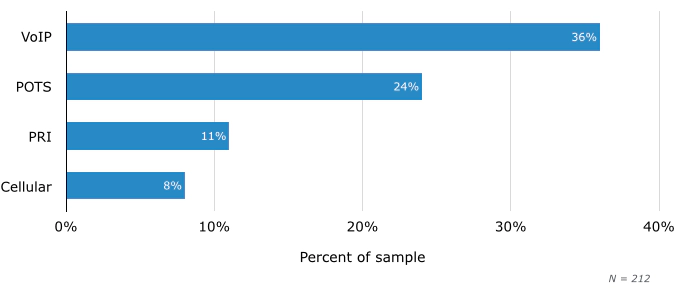 Small business VoIP phone system voice service type
Small business VoIP phone system voice service type
Interestingly, these figures reflect the responses of prospective buyers within the survey, which clearly indicates that VoIP is fast becoming the outright front runner in the SMB communications market as companies move away from POTS. It is also interesting to note that PRI (Primary Rate Interface) ISDN voice services only account for 11 % of market share. Perhaps this stems from a lack of a cost effective ISDN gateway that would enable SMBs to benefit from utilising hybrid IP PBX systems, but without further study I am only hazarding a guess at this point.
Another finding that provided further evidence to VoIP becoming the leading communications channel within the segment is that current adoption rates for VoIP phone systems is 29% (On-premise and cloud based combined) was nearly double that of a legacy PBX system which sits at 15%. Further to this point, the report highlights that growth within the Cloud based solution segment continues to gain traction, spurred on by the fact that cloud solutions provide SMBs with fewer IT resources the perfect platform from which to benefit from VoIP phone systems.
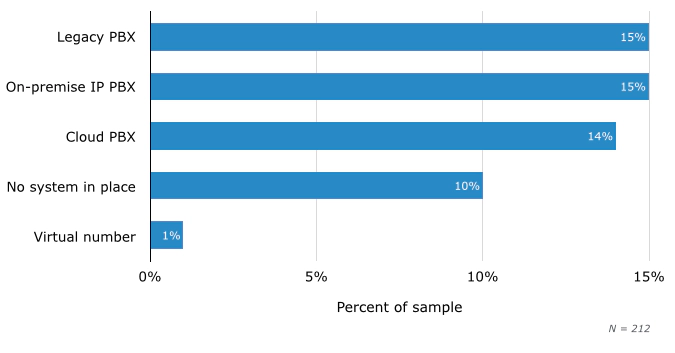 Small business VoIP phone service type
Small business VoIP phone service type
On this topic though, I would advise to tread carefully when choosing your phone system type. Of course, cloud systems are attractive with their lower upfront costs and the fact that companies will not require additional staff to complete maintenance or roll out updates, but as with most of these things, there is always a downside. Cloud based solutions tend to be somewhat inflexible when it comes to customisations and modifications. If fact, one buyer within the survey responded stated that
“the fact that we can’t really access anything in the system on our own is kind of frustrating. We have to call [the provider] to make any changes”.
If you need to or even want to heavily customise your solution, then on premise solutions are the way to go as the deliver more management and control elements. Then there is the cost issue. Cloud based solutions are extremely attractive due to their lower cost to entry and the flexibility they provide with cost spreading. As with all cost spreading there comes a point when the total costs begin to outweigh these benefits, so if you have say 20 plus employees, we would still recommend considering an on premise solution due to their lower TCO and potential for greater ROI. For more on this topic, check out Choosing a VoIP System
Auto Attendant and Call Queuing are Critical
When it comes to the functionality that buyers are looking for in their new phone systems, tools which are related to call routing and answering come up tops as the most critical influencers. Sitting proudly on top of the pile of phone system applications are AutoAttendants, which in itself is not really a surprise given the cost savings and process optimisations they can deliver. Next up came call queuing or to give it its technical name Automated Call Distribution (ACD) as these deliver SMBs with the power to implement skill, agent availability or caller waiting time based call routing as well as a number of other factors.
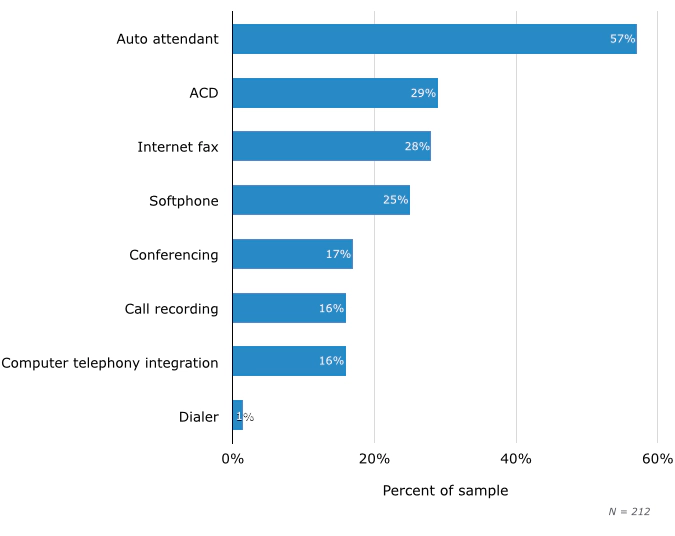 Small business VoIP Feature Requirements
Small business VoIP Feature Requirements
It is also great to see that IT buyers are becoming increasingly aware of the benefits that integrated softphone solutions can deliver, with 25 % stating that softphones are a must have, which is excellent news for remote workers. This fact is also significant as further evidence to increasing softphone adoption as a whole as companies strive to increase mobility, communication and collaboration for telecommuters through adopting BYOD strategies. A further indication of just how important softphone applications have become is that in the opinion of some IT buyers, applications that do not deliver an enhanced user experience is cause for switching vendors.
Flexible Call Forwarding is King
Delving deeper into what the IT buyers are really looking for when it comes to phone system functionality Call Forwarding came up top which when combined with the inability to do anything without our mobiles these days is quite understandable. Therefore, it is also hardly a surprise that mobile compatibility has slotted in at number 3 on the list, especially when one considers the increased availability of unified communications & collaboration tools for our mobile devices.
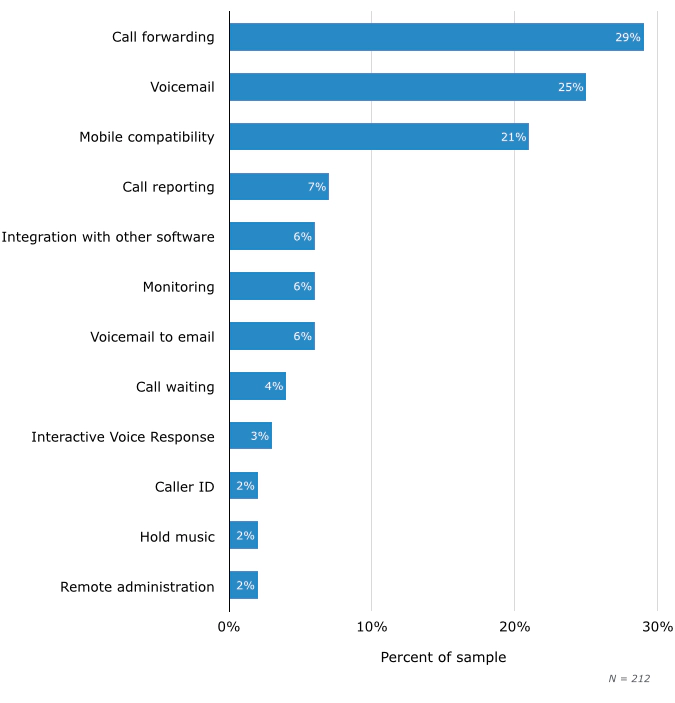 Small business VoIP Features
Small business VoIP Features
What is worth noting here, is firstly that there is a glaring omission from the list which is video conferencing which is interesting considering all the hype surrounding Video Collaboration. Secondly, it is interesting to see that the more elaborate functionality of IVRs or Voicemail to e-mail pale in significance to what could be described as standard features of any top of the range IP PBX solution, as generally these days most solutions deliver a full suite of UC and mobile UC functionality.
Ageing Inflexible Solutions Cause the Most Pain
The 2014 BuyerView report cited system reliability as the major factor when choosing to evaluate a new system, however the 2015 report highlight different pain points driving a buyers to decision to consider a new phone system, namely that their current systems having reached their end of life and suffering from a lack of scalability.
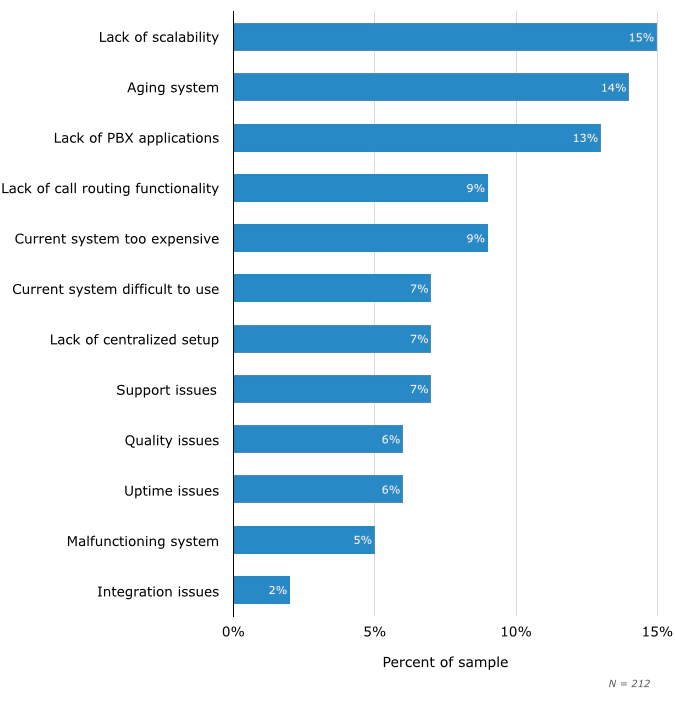 Small Business VoIP New System Drivers
Small Business VoIP New System Drivers
Perhaps somewhat surprising, although it really should not be, is that compared to lack of scalability, applications and ageing systems, the issues relating to call quality, uptime and budget are seemingly nowhere near as prevalent. This suggests that levels of service and audio quality being received by the buyers within the survey are of satisfactory levels, which from a vendor point of view is always pleasing to read.
Summary
All in all the Software Advice VoIP Software BuyerView delivers a unique insight into the state of play across the pond, as well as providing an excellent starting platform should you also be considering updating or upgrading your current phone systems.
Have you recently updated or are currently looking to update? We’d love to hear your thoughts and experiences, so let us know either here or one our social media.
If you are considering upgrading your business communications with a VoIP phone system and would like more information regarding pascom and our Business VoIP solutions, contact us and one of our advisers will be more than happy to help. Alternatively, why try our Free Edition including free life time pascom.cloud hosting?